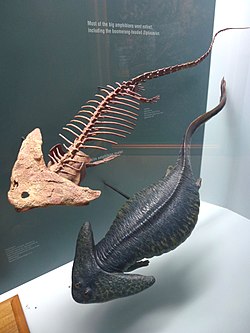| Diplocaulus | |
|---|---|

| |
| Reconstructed skeleton and life restoration model of Diplocaulus at the Denver Museum of Nature and Science | |
| Scientific classification | |
| Domain: | Eukaryota |
| Kingdom: | Animalia |
| Phylum: | Chordata |
| Clade: | Sarcopterygii |
| Clade: | Tetrapodomorpha |
| Order: | †Nectridea |
| Family: | †Diplocaulidae |
| Genus: | †Diplocaulus Cope, 1877 |
| Species | |
| |
| Synonyms | |
|
Genus-level:
Species-level:
| |
Diplocaulus (meaning "double stalk") is an extinct genus of lepospondyl amphibians which lived from the Late Carboniferous to the Late Permian of North America and Africa. Diplocaulus is by far the largest and best-known of the lepospondyls, characterized by a distinctive boomerang-shaped skull. Remains attributed to Diplocaulus have been found from the Late Permian of Morocco and represent the youngest-known occurrence of a lepospondyl.